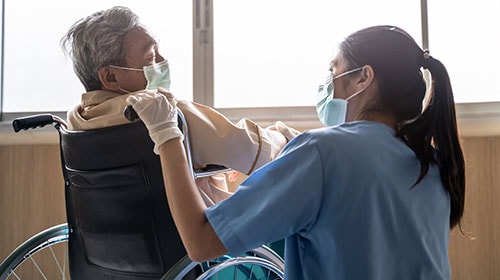Key points
- Even one invasive case of group A Streptococcus (GAS) infection in a long-term care facility (LTCF) should prompt an epidemiological investigation.
- Below details CDC's recommended approach to investigating one case of invasive GAS infection in a LTCF.

Laboratory or hospital
Actions the laboratory or hospitalB should take:
- Report the case to local public health authorities
- Notify the LTCF
- Save the GAS isolate
LTCF or public health agency
Actions the LTCF or public health agency should take
- Identify additional symptomatic cases
- Identify potential asymptomatic carriers
- Assess infection control measures
Identify additional symptomatic cases
Search
- Conduct a retrospective chart review of facility residents over previous month. Review records at LTCF, referral hospitals, and referral laboratories.
- Survey all current residents and healthcare personnel (HCP), including consultants, for symptoms of GAS infection.
- Culture symptomatic residents and HCP as clinically indicated.
Treat
Treat residents and HCP as clinically indicated. Review the page on antibiotic regimens for detailed guidance.
Keep looking for other cases
Identify potential asymptomatic carriers
Screen
Screen (by culture) close contacts of ill resident, including roommates and close social contacts.
Sites to culture include
- Throat
- Skin lesions
- Ostomy sitesC
Treat
Treat anyone with a positive culture. Review the page on antibiotic regimens for detailed guidance.
Re-screen
Re-screen, by culturing the same sites listed above, anyone with a positive culture 7 to 10 days after they complete treatment. Treat anyone with a positive culture.
Assess infection control measures
Considerations for multi-dose containers
Review and audit HCP adherence to infection control practices:
- Hand hygiene, preferably using alcohol-based hand rub/sanitizer
- Appropriate selection and proper use of personal protective equipment (PPE)D
- Cleaning and disinfection of environmental surfaces and reusable wound care equipmentE
- Maintaining separation between clean and soiled equipment to prevent cross contamination
- Dedicating multidose medication containers to a single patient or resident whenever possibleF
- If GAS is isolated from a wound AND accompanied by necrotizing fasciitis or streptococcal toxic shock syndrome, then it is considered an invasive GAS infection case.
- Often cases of invasive GAS will first be identified either by an acute care hospital where the resident of an LTCF has been transferred for additional evaluation and medical care or by a laboratory that processes specimens collected at LTCFs. Thus, these facilities should ensure that invasive GAS infection or positive GAS cultures collected from normally sterile body sites are reported to local public health authorities and the LTCF where the patient resides. Additionally, these facilities should save the isolate for possible future assessments of strain relatedness in case additional cases are identified.
- Examples of ostomy sites that should be cultured when screening residents for GAS carriage include gastrostomy and nephrostomy. Collection of cultures should only be performed by personnel trained in the appropriate management of these types of devices and ostomy sites. In order to assure sterility of sterile lines or devices is not compromised, cultures should not be collected from insertion sites for sterile lines or devices in the absence of signs or symptoms of infection. Staff should monitor the insertion sites for invasive medical devices (e.g., peripherally inserted central catheters) visually when changing the dressing or by palpation through an intact dressing on a regular basis, depending on the clinical situation of the individual resident. If patients have tenderness at the insertion site, fever without obvious source, or other manifestations suggesting local or bloodstream infection, the dressing should be removed to allow thorough examination of the site.
- As part of Enhanced Barrier Precautions (EBP) use of a gown and gloves is recommended during high-contact care activities (e.g., wound care; central line, urinary catheter, feeding tube, tracheostomy or ventilator device care or use) for residents with a wound or invasive medical device. Additional PPE use, as described below, is recommended to control a GAS outbreak. Residents with suspected or confirmed GAS infection or colonization should be placed on appropriate Transmission-Based Precautions pending culture results: 1) Wound—Residents with GAS cultured from a wound, ostomy, or device-insertion site should remain on Contact and Droplet Precautions until 24 hours after the initiation of effective antibiotic therapy and any wound drainage stops or can be contained by a dressing. HCP should then return to use of EBP. 2) Throat—Residents with GAS cultured from their throat should remain on Droplet Precautions until 24 hours after the initiation of effective antibiotic therapy. Note: Continued use of a facemask by HCP during all wound care activities or when handling invasive medical devices is recommended until the outbreak is over. HCP with suspected or confirmed GAS infection or GAS colonization should be managed as described in Epidemiology and Control of Selected Infections.
- EPA-registered disinfectants or detergents/disinfectants that best meet the overall needs of the healthcare facility for routine cleaning and disinfection of environmental surfaces and resident care equipment and proper handling of indwelling medical devices should be selected.
- Multidose medication containers (e.g., creams, sprays, ointments) should be dedicated to a single resident whenever possible. If it is not possible to dedicate an entire tube or container of wound care medication to an individual resident, then a small amount should be allocated (e.g., into a medication cup) for single resident use prior to the wound care procedure. If multidose medication containers are used for more than one resident, the medication container should be restricted to a centralized medication area (e.g., clean medication cart) and should not be brought into the immediate resident treatment area (e.g., resident's room/cubicle). The remainder of the multidose container should be properly stored in a dedicated clean area. Any container entering resident care areas should be dedicated for single-resident use or discarded after use.
